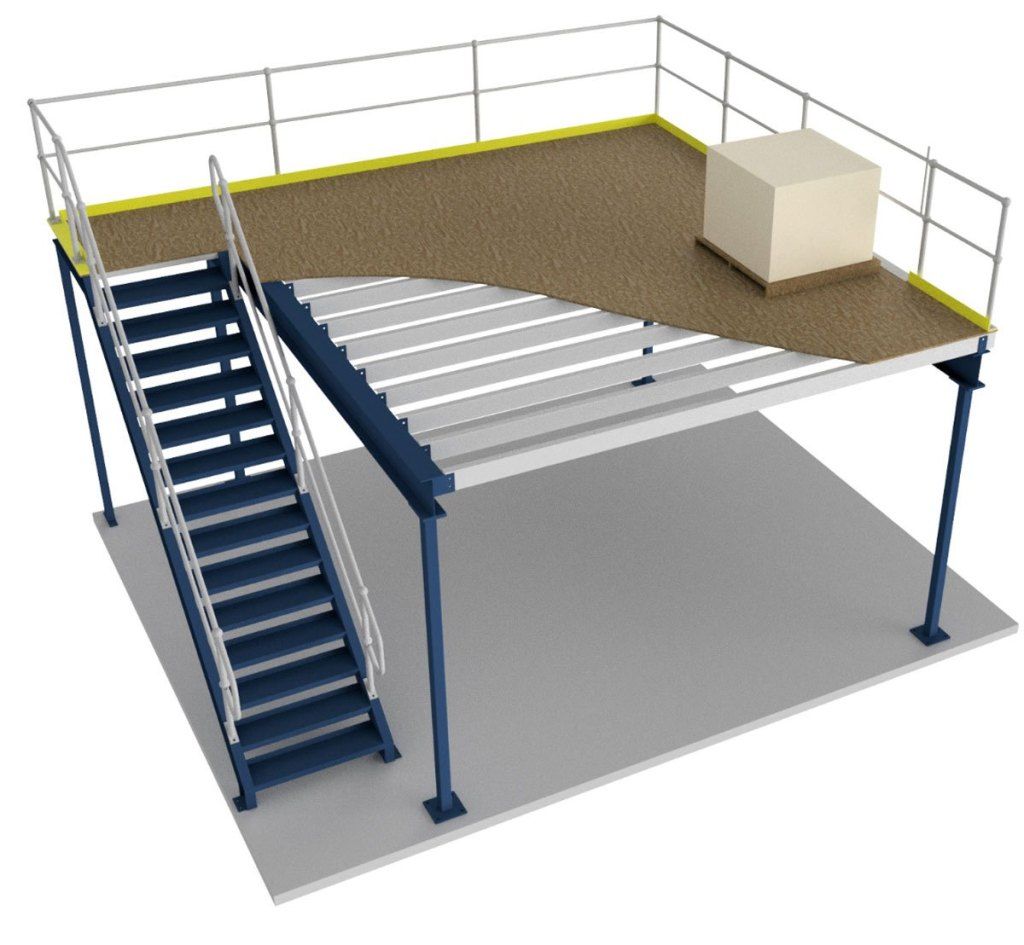Are you feeling cramped in your shop but not ready to commit to a costly move? A mezzanine floor might be the perfect solution! It’s a cost-effective way to increase your square footage without expanding your building’s footprint. Whether you need extra storage, a dedicated workspace, or even an eye-catching retail area, a mezzanine floor can be custom-designed to fit your unique needs. This comprehensive guide will walk you through every step of building a shop mezzanine floor, from the initial planning stages to the final installation.
Planning Your Dream Shop Mezzanine: What to Consider Before You Build
Before you start picturing your amazing new mezzanine, let’s lay the groundwork for a successful project. Careful planning is crucial to ensure your mezzanine is not only aesthetically pleasing but also safe, functional, and compliant with building codes.
1. Define Your “Why”
What’s the driving force behind your desire for a mezzanine? Are you looking to:
- Increase Storage Space: Create a dedicated area for inventory, equipment, or supplies.
- Establish a Dedicated Workspace: Design a separate office, workshop, or production area.
- Enhance Retail Space: Add a visually appealing level for displays, seating, or a unique shopping experience.
Clearly defining your objectives will guide your design choices and ensure your mezzanine aligns with your business needs.
2. Measure Twice, Build Once
Accurate measurements are essential for a successful mezzanine project. Grab your measuring tape and carefully note the following:
- Ceiling Height: Measure the distance from the floor to the ceiling in the area where you envision your mezzanine. This will determine the maximum height of your structure.
- Area Dimensions: Measure the length and width of the space to determine the potential footprint of your mezzanine.
- Obstacles: Take note of any existing structures, such as beams, pipes, or ductwork, that could interfere with your mezzanine design.
3. Familiarize Yourself with Building Codes
Building a mezzanine is not a DIY project you can undertake without consulting the rules. Building codes exist to ensure the structural integrity and safety of your mezzanine. Key aspects to consider include:
- Headroom Clearance: Building codes mandate a minimum vertical clearance, typically around 7 feet, both above and below the mezzanine floor.
- Mezzanine Area Restrictions: To prevent overcrowding and ensure proper ventilation, regulations often limit the mezzanine’s footprint to a certain percentage of the total floor area below.
- Emergency Exits: Just like any other floor, your mezzanine must have designated escape routes that meet building code requirements for accessibility and safety.
Remember, building codes can vary depending on your location, so it’s crucial to consult with your local building authority or a qualified professional to ensure compliance.
4. Explore Design Options: In-Plane vs. Joist Over Bearer
Two primary structural designs are commonly used for mezzanines:
- In-Plane Mezzanines: Imagine giant shelves anchored to your existing walls. These are typically suitable for lighter loads and offer a sleek, minimalist aesthetic.
- Joist Over Bearer Mezzanines: Picture a more traditional floor structure with beams supported by columns. This design is more robust and can handle heavier loads.
Your choice will depend on factors like the intended use of the mezzanine, the load-bearing capacity required, and your aesthetic preferences.
5. Prioritize Sustainability
Consider incorporating sustainable practices and materials into your mezzanine design:
- Reclaimed Wood: Repurpose wood from old structures for a unique, eco-friendly touch.
- Recycled Steel: Opt for steel with recycled content, reducing the environmental impact of your project.
- Energy-Efficient Lighting: Choose LED lighting to minimize energy consumption.
Shop Mezzanine Floor Design Ideas: Maximizing Space and Efficiency
A well-designed mezzanine floor can transform your shop, not just by adding square footage, but by optimizing functionality and enhancing its overall aesthetic.
Key Considerations for Mezzanine Design:
- Purpose-Driven Design: Let the intended use of your mezzanine guide your design decisions. A storage mezzanine will have different requirements than a retail display area or an office space.
- Strategic Location: Consider foot traffic flow, workflow efficiency, and natural light when determining the placement of your mezzanine.
- Accessibility Matters: How will you and your team access the mezzanine? Stairs, ladders, or even a small elevator are all possibilities, depending on your needs and budget.
- Material Selection: Steel is a popular choice for its strength and durability, but you can explore other options like wood or concrete to match your shop’s style.
- Lighting is Key: Don’t let your mezzanine become a dark and uninviting space. Maximize natural light with large windows or skylights, and supplement with well-placed artificial lighting.
Pros and Cons of Shop Mezzanines:
Advantages:
| Benefit | Description |
|---|---|
| Space Efficiency | Doubles usable area without expanding the building’s footprint. |
| Cost-Effective | Typically less expensive than building a full second story. |
| Versatility | Adaptable to various uses, including storage, office space, display areas, and more. |
| Enhanced Workflow | Creates a separation of functions, potentially improving workflow and efficiency. |
| Increased Property Value | A well-designed mezzanine can boost the overall value of your property. |
Disadvantages:
| Disadvantage | Description |
|---|---|
| Reduced Ceiling Height | Can make the lower level feel cramped if not planned carefully. |
| Noise Transfer | Sound travels easily between the mezzanine and the main floor, which might be a concern for some businesses. |
| Fire Safety | Requires careful planning to meet fire safety codes, including adequate fire suppression systems and exits. |
| Building Regulations | Local building codes may limit your design options. |
If you are in need of additional storage and workspace, consider building a shed with a mezzanine. A a 3,500 level mezzanine floor can provide you with the extra space you need to store your belongings or work on projects.
Navigating Building Codes and Regulations for Shop Mezzanines
Building codes and regulations are in place to ensure the safety and structural integrity of your mezzanine. While this section provides a general overview, it’s essential to consult with your local building department or a qualified professional for specific requirements in your area.
Key Building Code Considerations:
- Headroom: Most building codes require a minimum of 7 feet of vertical clearance above and below the mezzanine floor. This ensures adequate headroom and prevents people from bumping their heads.
- Mezzanine Area: Regulations often limit the area a mezzanine can occupy, typically to one-third or less of the total floor area below. This precaution helps to maintain proper ventilation and prevent the mezzanine from overwhelming the space.
- Means of Egress: Your mezzanine must have at least two distinct means of egress (escape routes), just like any other floor. These exits should be strategically located and comply with width and accessibility requirements to ensure safe evacuation in case of emergencies.
- Openness: Mezzanines are generally required to maintain an open concept to the room below, allowing for airflow and natural light penetration. However, low walls (typically up to 42 inches high) are often permitted for safety, privacy, or aesthetic purposes.
Why Compliance Matters:
- Safety First: Building codes are designed to protect people from accidents and hazards.
- Legal Consequences: Failing to meet building codes can result in fines, legal issues, and even the closure of your shop.
- Insurance Coverage: Your insurance company may not cover accidents or damages if your mezzanine doesn’t meet building codes.
- Property Value: A mezzanine built to code adds value to your property and can make it more attractive to potential buyers in the future.
Building Your Dream Mezzanine
Building a mezzanine is a significant undertaking that requires careful planning, professional expertise, and strict adherence to safety regulations. By following the guidelines outlined in this guide and seeking the advice of qualified professionals, you can create a functional, stylish, and code-compliant mezzanine floor that elevates your shop to new heights.
- Greenhouse Storage Shed Combos: Your Guide to Combining Growing and Storage - April 21, 2025
- Greenhouse Shed Combo: Design, Build & Grow Year-Round - April 21, 2025
- Gingham vs. Plaid: What’s the Difference? A Complete Guide - April 21, 2025










